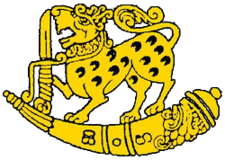All of a Rifle Regiment’s fundamental customs and traditions derive from their practical application to these roles. In the words of Colonel Coote Manningham 'to do everything that is necessary and nothing that is not'.
Rifle Regiments have been foremost in individual marksmanship since their inception. In training, Riflemen were classified as first, second or third class shots. First class shots were called ‘marksmen’, who were distinguished by a green cockade, and the best shooting Company was given a place of honour on parade. Riflemen were expected to make every shot count. Equipped with the rifle, the Rifle Brigade and 5th Battalion 60th were the elite of an army whose musketry was superior to all others. The British Army was the only army in the Napoleonic Wars to consistently inflict more than half the casualties on the enemy with small arms fire.
The rifle, a Baker was lighter and shorter than the standard infantry ‘Brown Bess’ smooth-bore musket. The barrel was 30 inches long as compared to the 46 inch barrel of the musket. While the old smooth-bore could only hit a man at a range of 100 yards or less, the Baker rifle was capable of great accuracy up to 300 yards and, in the hands of an exceptional shot, 500 yards. It was equipped with a long sling which riflemen were trained to use to steady their aim. It was found that when the short triangular bayonet of the musket was fixed, riflemen were at a disadvantage when controlled by infantry armed with a musket and a bayonet, so they were given a 27 ½ inch long sword-bayonet fitted with a sword handle. Hence the use of the term ‘sword’. The term ‘bayonet’ is never used. Officers’ swords were lighter than regular swords, with a bugle-horn in lieu of the Royal Cypher.
Colours are never carried. Their original purpose of being easily seen and identified to serve as a rallying point in time of crisis did not fit either the riflemen’s need for concealment or their role, which involved operating in widely dispersed groups. Regular infantry display their battle honours on their colours. Rifle Regiments ordinarily had their battle honours on their cap badges and latterly on their drums. However, drums originally had no place in a Rifle Regiment.
Traditionally an instrument of alarm and only considerably later used to beat marching step, drummers patrolled the street and ‘beat to quarter’s soldiers who were scattered throughout the town or village where they bivouacked’. This was not needed by units of the Light Division who were usually bivouacked on a wide front and whose battalions were seldom assembled as formed bodies. Trained to a constant readiness, word or mouth, the whistle, and occasionally the bugle-horn sufficed to bring then to full alert. Today, Retreat is sounded by the Royal Green Jackets, rather than beaten.
The bugle-horn, in Rifle parlance the 'horn', occupies a place of honour because of its importance in the Light Division. Movement in extended order could not be controlled by voice, so it was directed by the officers' and sergeants' whistles, worn on their cross-belts and by cow-horns carried by buglers with every company and platoon. Different calls were devised to meet those needs, many of which were later adopted by other units of the British Army. Calls ended on a short, clipped note, which was the executive for action as in a word of command. Bugle 'calls' were not referred to as ‘calls' but as 'horns'.
Differences in drill all derive from the practical aims of ingrained alertness, eliminating unnecessary movements, minimizing fatigue and being ready for action, ways suited to the battlefield as opposed to ceremony. Exaggerated movements, long pauses between movements, stamping of feet, slapping of the rifle and crashing of rifle butts to the parade square had no place in the drill of the Rifle Regiments. Both men and weapons were too highly regarded to permit such abuses. Noise was avoided because it could give a position away to the enemy.
A relic of the pike-carrying days, the 'slope-arms', with the rifle carried on the left shoulder with muzzle pointed upward at an angle so the weapon posed no danger to the comrade behind, had never been used by Rifle Regiments because it was an unnecessary drill movement and it made the man conspicuous.
The command 'attention' was never used. Riflemen were left at the 'stand easy' to avoid fatigue caused by standing at a rigid position. On the cautionary 'look/stand to your front' they become to the 'at ease' position and to ‘attention’ on the order party, guard, platoon, company, battalion or Rifles as appropriate.
The Royal Green Jackets and The Royal Winnipeg Rifles returned to the 'at ease' positions after all drill movements to show their traditional regard for the man.





